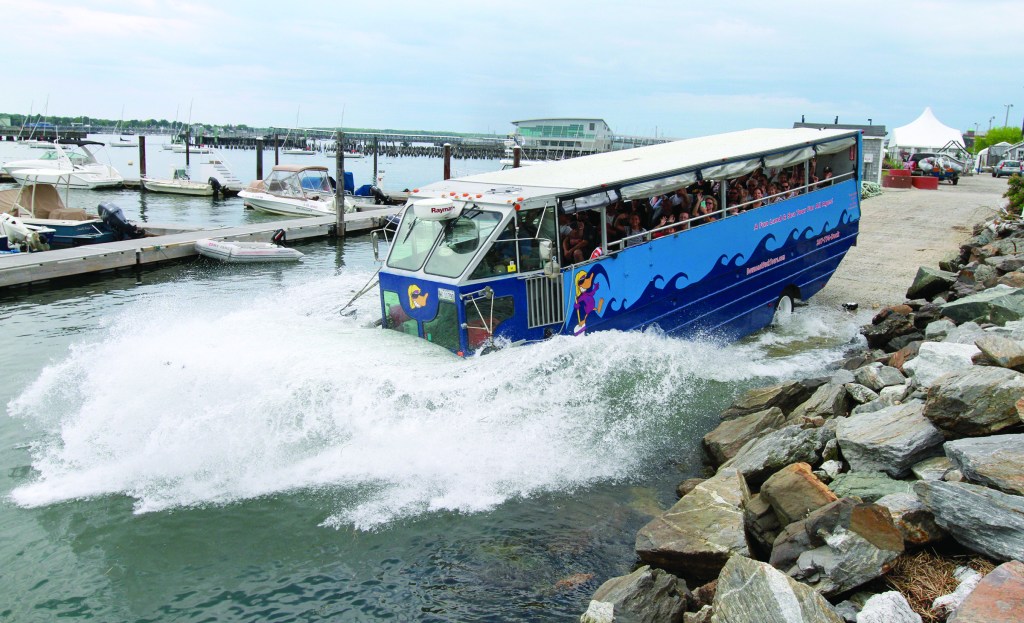I know it’s not a good idea to drive my Toyota Corolla into the Fore River. So why can the bus operated by Downeast Duck Adventures drive into the water and operate like a boat?
I hate to think the out-of-towners on the tour bus know more about this local phenomenon than I do. Lucky for me, the gracious folks at Downeast Duck Adventures welcomed me on a tour.
Joe Stanley of Falmouth, the business owner and captain, explained the vehicle technology to me. Derek Meader is the tour guide. He draws on his upbringing in Portland to share his wisdom about our city.
Captain Joe said I could drive into the water, but the difference between my car and his duck boat is that I might not be able to get out again. His vehicle is a unique design, because the tour is one of the few that go into salt water.
The DUKW, a more common amphibious tour vehicle that was originally used by the U.S. military in World War II, does not meet the strict standards of the Coast Guard for operation in the ocean.
Stanley describes himself as a “decky,” not an engineer. He earned his bachelor’s degree in Nautical Science from Maine Maritime Academy in 1982 and has worked as a chief mate and in marine construction. To build his duck boat, he worked with marine architect Roger Long of Cape Elizabeth.
Designing the vehicle was a bigger project than expected, because of challenges in meeting specifications for both the Coast Guard and the Department of Transportation. For example, a certain width was desirable to meet the Coast Guard’s requirement for stability – but then the vehicle wouldn’t fit down the road.
It’s odd to stand next to the boat and see a headlight, a starboard marker light, a side view mirror, and an anchor all mounted together. It’s even more strange to drive in and out of the water.
The Ford turbocharged diesel engine is connected to an automotive transmission to drive the wheels on land. Descending the boat ramp, Stanley shifts that into neutral and turns on a power take off for a marine transmission to drive the propeller in water. He seamlessly trades the steering wheel for the tiller.
The aluminum hull is watertight thanks to seals around the axles, brake lines, and steering linkage. A thick layer of grease protects chassis components exposed to the salt water. The suspension is specially designed to adjust between the wheels resting on the road or dangling in the water. In marine operation, the automotive radiator is backed up by keel coolers – an additional loop of the cooling system that transfers heat to the ocean water.
When coming ashore, Meader asks the passengers to help by flapping their arms and quacking. The real work is done by Stanley as he inconspicuously shifts back to the automotive transmission. The disc brakes shed their water, and the wheels are ready to roll again.
The amphibious vehicle technology is fascinating to a gearhead like me, but the Portland tour is equally interesting. The ride is smooth and the dialogue is fun.
I am happy to know that Downeast Duck Adventures is representing Portland to our fair-weather visitors. The duck boat’s unique design to meet the rigors of the salt-water environment is a true symbol of Mainers’ hardiness.
Ruth Morrison is an Automotive Technology Instructor and Department Chair at Southern Maine Community College. She holds certification as an ASE Master Technician and Advanced Level Specialist and was a former Ford Senior Master Technician. She graduated from the Ford ASSET Automotive Technology program at Central Maine Technical College and most recently earned her master’s in Adult Education from the University of Southern Maine.
Send questions/comments to the editors.



Success. Please wait for the page to reload. If the page does not reload within 5 seconds, please refresh the page.
Enter your email and password to access comments.
Hi, to comment on stories you must . This profile is in addition to your subscription and website login.
Already have a commenting profile? .
Invalid username/password.
Please check your email to confirm and complete your registration.
Only subscribers are eligible to post comments. Please subscribe or login first for digital access. Here’s why.
Use the form below to reset your password. When you've submitted your account email, we will send an email with a reset code.